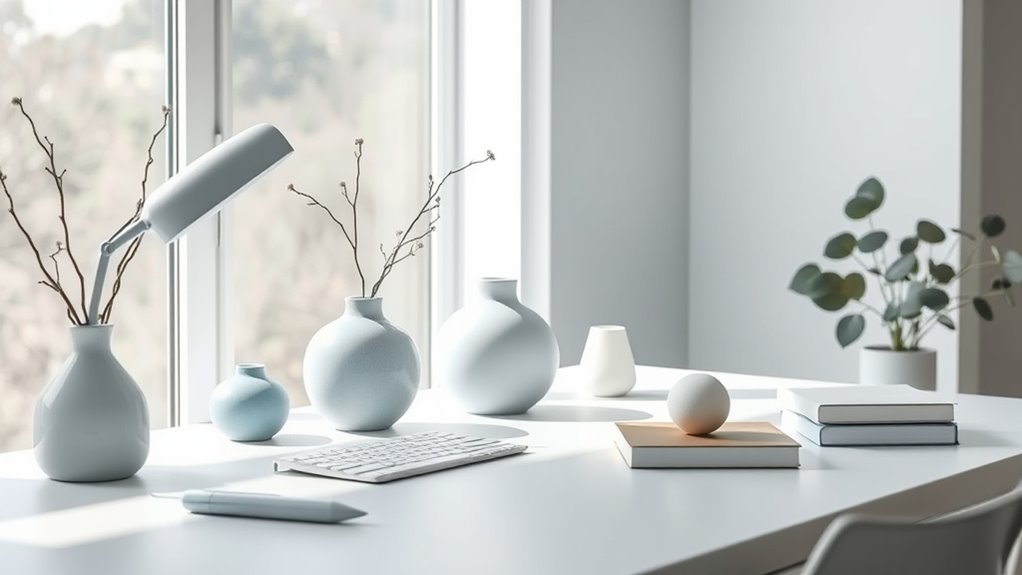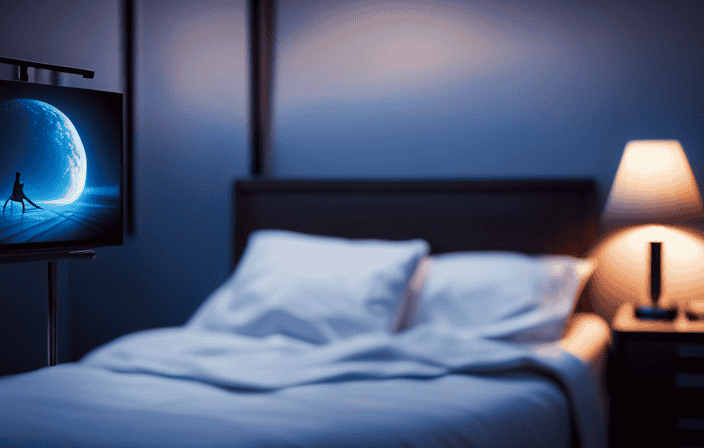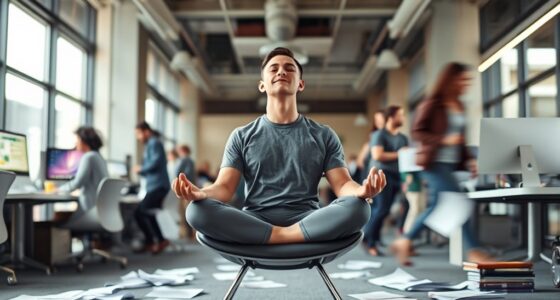Colors and shapes in your workspace act as visual anchors that can gently influence your mood. Soft, muted hues like blue and green promote calmness and focus, while rounded shapes evoke softness and unity, helping you feel more relaxed. Sharp angles or bright colors might energize but can also create tension. By choosing calming colors and gentle curves, you set a peaceful tone, which holds the power to improve your day—learn more about how these subtle cues work.
Key Takeaways
- Soft, muted colors like blue and green promote relaxation and reduce stress in workspace environments.
- Circular shapes and rounded furniture evoke feelings of softness, unity, and calmness subconsciously.
- Blue colors are associated with trust and serenity, helping to create a peaceful workspace atmosphere.
- Rounded decor elements soften the space and encourage ease and comfort among occupants.
- Limiting bright, energizing colors prevents overstimulation, supporting focus and tranquility.

Have you ever noticed how certain images or symbols help you quickly understand or remember a message? That’s the power of visual anchors—subtle cues that steer your emotions and perceptions without you even realizing it. In your workspace, these anchors can shape how you feel, boosting your calm and focus. Two key elements play a essential role here: color psychology and shape symbolism. When you understand how these work, you can intentionally craft an environment that promotes tranquility and productivity.
Color psychology explores how different hues influence your mood and behavior. Soft, muted colors like blues and greens are known for their calming effects, making them ideal choices for your workspace. Blue, often associated with trust and serenity, helps lower stress levels and fosters concentration. Green, linked to nature and renewal, can ease eye strain and create a sense of balance. Bright or intense colors, such as red or yellow, tend to energize or stimulate, so they’re best used sparingly if calmness is your goal. When you paint your walls, choose decor, or even wear clothing in these soothing shades, you reinforce a peaceful atmosphere. The brain responds to these colors on a subconscious level, creating an environment that supports relaxation and focus.
Shape symbolism also influences how your workspace feels. Circles and rounded shapes evoke softness, unity, and completeness. They remind you of wholeness and can make a space feel more welcoming and less rigid. Incorporating circular elements—think rounded desks, soft-edged furniture, or circular artwork—can subconsciously promote calmness. Conversely, sharp angles and straight lines tend to communicate stability and order but might also feel more rigid or formal. If you want to soften a space’s tone, opt for curved shapes that invite a sense of ease. Understanding shape symbolism allows you to select furniture, decor, and layout arrangements that subconsciously support tranquility.
Frequently Asked Questions
How Do Visual Anchors Influence Long-Term Productivity?
Visual anchors influence your long-term productivity by reinforcing positive habits through environmental consistency. When you establish familiar colors and shapes as anchors, they become cues that signal your brain to focus and stay calm, making habit formation easier. Over time, these consistent visual cues help you maintain a productive mindset, reduce distractions, and create a steady routine, ultimately boosting your ability to stay on track and achieve your goals consistently.
Can Specific Colors Trigger Stress Instead of Calm?
Colors can be like a double-edged sword, sometimes triggering stress instead of calm. In color psychology, certain shades like bright red or harsh yellow activate your stress response, making you feel anxious or overwhelmed. You might not realize it, but these colors can heighten your tension, especially in a workspace. Choosing calmer hues like blue or green helps soothe your mind and keeps stress at bay, promoting focus and relaxation.
Are There Cultural Differences in Color Perception?
You might wonder if cultural differences influence how you perceive colors. Yes, cultural color symbolism varies, affecting cross-cultural design choices. For example, white symbolizes purity in some cultures but mourning in others. When designing spaces for diverse groups, consider these differences to create calming environments. Recognizing how cultural perceptions shape color responses helps you choose hues that promote calmness universally, ensuring your workspace feels welcoming and soothing to everyone.
How Do Shapes Impact Focus and Creativity?
Shapes are like the silent conductors of your workspace, guiding your focus and sparking creativity through shape symbolism. They influence visual pattern recognition, helping you organize ideas and maintain clarity. Sharp angles can energize, while smooth curves promote calm. By consciously selecting shapes, you shape your environment for productivity. Your awareness of these subtle cues empowers you to craft a space that naturally fosters concentration and inspires innovative thinking.
What Are the Best Practices for Incorporating Visual Anchors?
To incorporate visual anchors effectively, you should use decorative accents that promote calm and focus, like calming colors or natural shapes. Balance these with ergonomic design principles to guarantee comfort and reduce stress. Place accents strategically in your workspace, creating focal points that guide your attention and foster tranquility. Regularly update and adjust these elements to maintain a serene environment, helping you stay focused and inspired throughout your workday.
Conclusion
So, next time your workspace feels like a chaos tornado, remember: a splash of calming blue or a gentle curve can turn that disaster into a zen haven. Who knew that tiny color shifts and shapes could wield such power? Just don’t blame us if your coworkers start mistaking your desk for a spa retreat—they might get jealous. But hey, at least you’ll be the calmest chaos creator around, right? Your serene sanctuary awaits—just a few color tweaks away.









